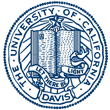
This REU program was funded through NSF PHY-1560482.
Students' names link to their final papers. Advisors' names link to the research group web pages.
Astrophysics
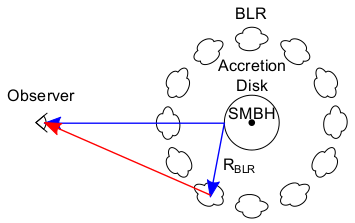
Reverberation mapping (see schematic above) compares two signals originating near a single black hole: light received from a direct path, and light that heads towards Earth only after scattering off the accretion of dust that surrounds the black hole. Combining these signals can give information on the size and composition of the accretion disk and on the mass of the black hole itself. Matt Bellardini (Ithaca College; advisor Stefano Valenti) worked on converting raw signals from reverberation mapping measurements into usable data: removing cosmic ray signals, calibrating the detector sensitivity as a function of wavelength, etc. His software enhancements sped up the data processing by nearly a factor of 50, making long-time observations much more practical.
SOFIA, the Stratospheric Observatory for Infrared Astronomy, is a telescope on an airplane. The limits on the flight time make measurement speed and calibration times particularly important. Ira Globus-Harris (Reed College; advisor Matt Richter) investigated a model of the sky and compared to data both from SOFIA and from the large earth-based telescopes in Hawaii. Ira ran the model manually and found good agreement with the best-understood wavelengths of the spectrum. Automating and incorporating the model into the existing image analysis software should significantly decrease the necessary calibration time and correspondingly increase the time during each flight devoted to data acquisition.
Biological Physics
Talia Sopp (University of Puget Sound; advisor Daniel Cox) studied a possible synthetic protein that might have practical applications. Actually producing a synthetic protein, especially in usable quantities, can be expensive, so Talia calculated expected production rates and how to maximize the yield of the desired protein. She found that the yield could be sufficient to make an experimental attempt worthwhile, and her suggested parameters for the synthesis should give at least a rough idea of how to optimize the process.
Complex Systems
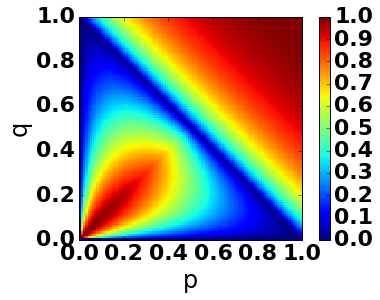
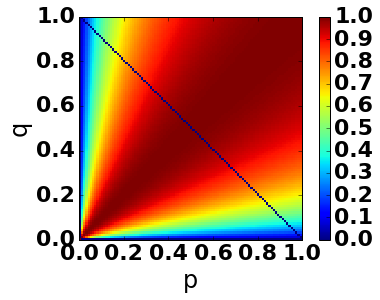
Josh Ruebeck (Carleton College; advisor Jim Crutchfield) looked at how to define the complexity of a partly random process. A system can be in one of several states, and develops from one to another over time. A Markov chain is a sequence of states with no memory: the choice of a state depends only on the state directly before it. Randomness enters because the new state need not be precisely determined; perhaps if the system is in state A it has a 30% chance of remaining there, a 20% chance of moving to state B, and a 50% chance of moving to state C. However, if the system remains in state A then the probabilities are identical at the next time step, with no adjustment for the fact that state A has repeated. By working with relatively simple example processes, Josh showed that the complexity needed to generate a process (roughly, how complicated the rules describing it are) is often strictly less than that needed to predict the process from the outputs alone. The pictures above show generative (left) and predictive (right) complexity, as a function of certain transition probabilities p and q.
Condensed Matter Experiment
The energetics of a material's surface are very different from those within the bulk far away from any edge. Atoms deposited on a smooth surface may form a single layer, but they may also form more complicated structures. Hazel Betz (Oregon State University; advisor Shirley Chiang) followed up on an observation of tiny pyramids formed by germanium. A main question was whether traces of silver from the sample holder could have contaminated the sample and served as nucleation sites for the pyramids, which seemed to appear only after "cleaning" the samples by bombarding them with argon ions. Possibly the argon ions were dislodging silver from the sample holder and allowing it to resettle on the sample itself. Hazel worked over the summer to ready the the scanning tunneling microscope by repairing various pieces, and eventually measurements with a different sample holder indeed showed an absence of pyramids. Identifying silver atoms as nucleation sites may allow deliberate, controlled growth of such surface structures in the future.
Familiar fluid vortices include tornadoes and the swirl of water down a drain, but in general it is difficult to define exactly what classical fluid flows are vortices. The situation is different in superfluid helium, a quantum fluid that can exist at temperatures below 2 Kelvin. Here vortices are well-defined objects that can be manipulated and observed individually. Daniel Eilbott (University of Texas at Dallas; advisor Rena Zieve) studied a vortex "pinned" at a certain location and unably to move, testing what disturbances enabled the vortex to free itself. He found that abrupt temperature changes, which induce a flow velocity in the superfluid, are key to depinning the vortex. His vortices proved noticeably more stable than those in an earlier, very similar measurement. Since a change in the experimental geometry meant that a given rate of temperature change now induces a smaller flow, this observation confirms the importance of the flow velocity in depinning.
Qianni Jiang (Central China Normal University; advisor Rena Zieve) did computer simulations related to particular experiments on superfluid helium. She found numerical solutions of Laplace's equation inside a container with cylindrical symmetry but with a relatively abrupt radius change halfway along its length. She found that the slanted surface near the radius change converts any horizontal asymmetries in the boundary conditions into a vertical velocity component. This may explain experimental signatures from when a superfluid vortex approaches the region where the radius changes. Qianni also began the next step of incorporating the Laplace solver into more general vortex simulation code, in a way that is practical from a computation time perspective.
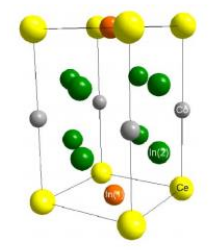
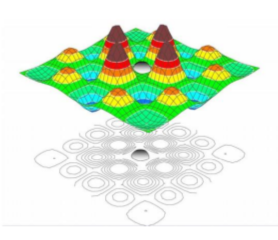
When some of the indium atoms in CeCoIn5 (crystal structure, above left) are replaced by cadmium, a region of magnetic order forms near the impurity (magnetic structure, above right). The magnetism is antiferromagnetic, meaning that there is no net magnetic moment on a macroscopic scale but that locally the nuclear spins form an ordered array. AJ LaPanta (Saint John's University; advisor Nick Curro) used nuclear magnetic resonance (NMR) to study the onset of this magnetism. The NMR measurements show peaks as a function of excitation frequency, with each peak corresponding to a matching between the excitation frequency and the energy needed for a transition between nuclear spin states. As temperature decreases, these peaks broaden. This indicates growth of the magnetic regions; as the regions become larger, they tend to include nuclei with more varied local environments which slightly shift the transition energies.
Eliovardo Gonzalez (CSU San Bernardino; advisor Dong Yu) grew nanostructures with possible applications in photovoltaic solar cells. The materials are promising because growing them is simple and inexpensive, but they need more study and better characterization. Elio measured current-voltage curves of samples illuminated by a laser. He found that much of the behavior could be described by a model of back-to-back diodes, where the diodes represent barriers at the electrical contacts to the nanostructures. The devices remain to be optimized for power conversion applications.
Condensed Matter Theory
Noelle Blose (Middlebury College; advisor Rajiv Singh) made numerical studies of localization in a disordered system. The wave function associated with a particle gives the probability of the particle's being at different sites in a lattice, and the relative values of the wave function at different sites determine how spread out (or delocalized) the particle is. Noelle added time-dependent disorder to the lattice, testing both random and periodic time dependence. She found true localization for the former, but only a partial tendency towards localization for the periodic system. A next step will be to test a system with multiple particles to see how the effects of particle interactions.
Natasha Proctor (Cal Poly San Luis Obispo; advisor Richard Scalettar) examined how a time-dependent potential in one dimension leads to localization. Time-independent random disorder in one dimension (such as a chain of mostly identical atoms with occasional "impurity" atoms inserted) always produces localized electronic states, but changes to the potential over time could allow trapped electrons to escape. Natasha approximated time dependence through a piecewise constant function, which allowed her to solve for exact eigenstates at each step of the potential. She used both random and periodic time dependence. She found that time dependence indeed decreases the degree of localization, and that the electron states became more extended with random time dependence than with the periodic variation.
Nuclear Experiment
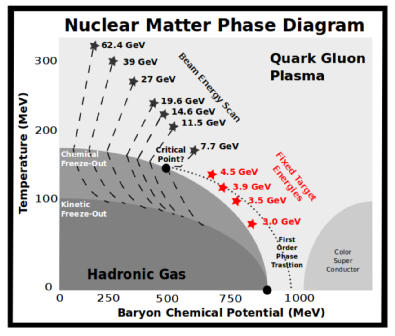
The Relativistic Heavy Ion Collider (RHIC) uses gold ions to generate very high-energy collisions and wrench free the quarks that compose the nucleons. The resulting quark-gluon plasma (above) may have interesting properties at a somewhat lower energy than RHIC's standard range, so new fixed-target experiments are being developed. This lowers the collision energy by using only one high-speed gold ion rather than colliding two ions moving in opposite directions. Elena Amparo (College of William and Mary; advisor Daniel Cebra) worked on a new version of the event made calculations of how to distinguish different particles -- kaons, pions, and protons -- that ultimately result from these collisions. Each type of particle has its own characteristic energy and momentum, although the spectra do overlap and the identification can only be done at a statistical level (below). Elena used data from accidental fixed-target collisions, when off-center ions hit the pipe containing the beamline, to test her results.

Particle Experiment
The existence of invisible matter was inferred decades ago from the rotation rates of galaxies. Without additional mass binding galaxies together, their rotation rates ought to fling their stars outward. Since the extra mass cannot be detected visually, it was called "dark matter." Various lab experiments have attempted, so far unsuccessfully, to observe dark matter particles. LZ (LUX-ZEPLIN, combining the acronyms for the predecessor experiments to LZ) is a second-generation liquid xenon experiment, an attempt to detect dark matter through its gravitational interaction with xenon nuclei. Jyothis Johnson (CUNY Hunter College; advisor Mani Tripathi) did early work towards making the upcoming dark assisted in the design phase by characterizing the LZ amplifier and modelling the coaxial cables that connect it to the photomultiplier tubes at the xenon bath. His software can propagate a simulated dark matter signal through the electronics and determine how well it can ultimately be distinguished; this will play a role in selecting what model cable to use in the experiment.